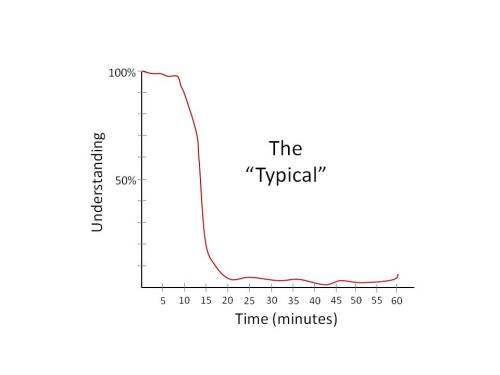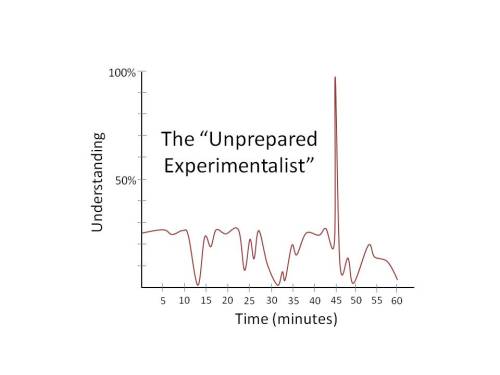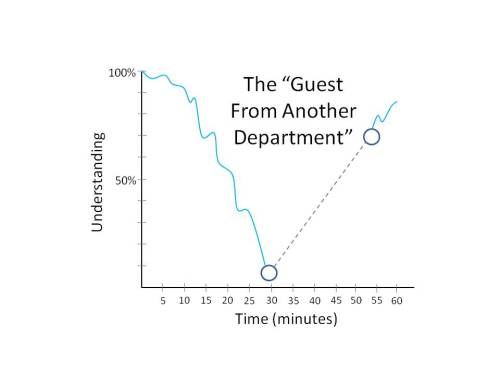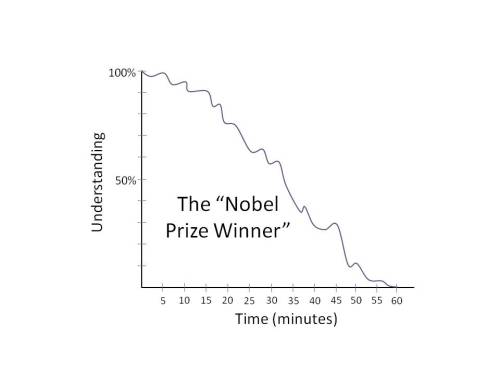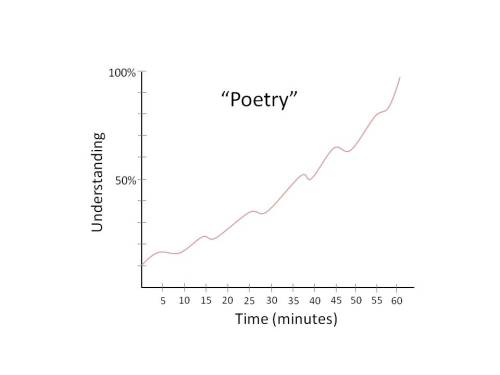
Archive for the ‘Comix’ Category
Posted in Comix, Image, tagged anti-vaxxers, science on March 6, 2019| 2 Comments »
John Cage’s 4’20”
Posted in Comix, tagged 4'33", John Cage, Matt Damon, Snoop Dogg on January 25, 2016| 2 Comments »
Obscure joke of the day
Posted in Comix, tagged egyptian hieroglyphics, MC Hammer on November 1, 2013| 6 Comments »
An H-R diagram for the 9 kinds of physics undergrad
Posted in Comix, Physics, tagged H-R diagram, math, Physics, undergrads on October 10, 2013| 6 Comments »
In my continuing effort to present cutting-edge research, I present here my findings on the 9 kinds of physics undergrad.
First, let’s look at a scatter plot of Ability vs. Effort for a little more than 100 students. (This data was taken over a span of five years at a major university which will remain unnamed. Even though it’s Wake Forest University.)
Student ability is normalized so that 1 is equivalent to the 100th percentile, 0 is the 50th percentile, and –1 is the 0th percentile. [This matches the work of I. Emlion and A. Prilfül, 2007] Ability scores below –0.5 are not shown (such students more properly belong on the Business Major H-R diagram).
On the x-axis is student effort, given as a spectral effort class [this follows B. Ess, 2010]:
O-class: Obscene
B-class: Beyond awful
A-class: Awful
F-class: Faulty
G-class: Good
K-class: Killer
M-class: Maximal
As you can see, most students fall onto the Main Sequence.
The Typical student (effort class G, 50th percentile) has a good amount of effort, and is about average in ability. They will graduate with a physics degree and eventually end up in sales or marketing with a tech firm somewhere in California.
The Giant student (effort class K, 75th percentile) has a killer amount of effort and is above average in ability. Expect them to switch to engineering for graduate school.
The Smug Know-it-all student (effort class O, 100th percentile) is of genius-level intellect but puts forth an obscenely small amount of effort. They will either win the Nobel prize or end up homeless in Corpus Christi.
The Headed to grad school student (effort class B, 75th percentile) is beyond awful when it comes to work, and spends most of his/her time playing MMORPG’s. However, they score well on GRE’s and typically go to physics graduate schools, where to survive they will travel to the right (off the main sequence).
The Headed to industry student (effort class F, 55th percentile) is slightly above average but has a faulty work ethic. This will change once they start putting in 60-hour weeks at that job in Durham, NC.
The Hard working math-phobe student (effort class M, 30th percentile) is earnest in their desire to do well in physics. However, their math skills are sub-par. For example, they say “derivatize” instead of “take the derivative”. Destination: a local school board near you.
The Supergiant student (effort class K, 100th percentile) is only rumored to exist. I think she now teaches at MIT.
The Frat boy student (effort class O, 50th percentile) is about average, but skips almost every class. Their half-life as a physics student is less than one semester. They will eventually make three times the salary that you do.
The White dwarf student (effort class B, 30th percentile) is below average in ability and beyond awful when it comes to putting forth even a modicum of effort. Why they don’t switch to being another major is anyone’s guess.
***********************************************************************************
If you enjoyed this post, you may also enjoy my book Why Is There Anything? which is available for the Kindle on Amazon.com. The book is weighty and philosophical, but my sense of humor is still there!
***********************************************************************************
I am also currently collaborating on a multi-volume novel of speculative hard science fiction and futuristic deep-space horror called Sargasso Nova. My partner in this project is Craig Varian – an incredibly talented visual artist (panthan.com) and musician whose dark ambient / experimental musical project 400 Lonely Things released Tonight of the Living Dead to modest critical acclaim a few years back. Publication of the first installment will be January 2015; further details will be released on our Facebook page, Twitter feed, or via email: SargassoNova (at) gmail.com.
The 9 kinds of physics seminar
Posted in Comix, Physics, tagged Physics, physics seminars, science on October 3, 2013| 174 Comments »
As a public service, I hereby present my findings on physics seminars in convenient graph form. In each case, you will see the Understanding of an Audience Member (assumed to be a run-of-the-mill PhD physicist) graphed as a function of Time Elapsed during the seminar. All talks are normalized to be of length 1 hour, although this might not be the case in reality.
The “Typical” starts innocently enough: there are a few slides introducing the topic, and the speaker will talk clearly and generally about a field of physics you’re not really familiar with. Somewhere around the 15 minute mark, though, the wheels will come off the bus. Without you realizing it, the speaker will have crossed an invisible threshold and you will lose the thread entirely. Your understanding by the end of the talk will rarely ever recover past 10%.
The “Ideal” is what physicists strive for in a seminar talk. You have to start off easy, and only gradually ramp up the difficulty level. Never let any PhD in the audience fall below 50%. You do want their understanding to fall below 100%, though, since that makes you look smarter and justifies the work you’ve done. It’s always good to end with a few easy slides, bringing the audience up to 80%, say, since this tricks the audience into thinking they’ve learned something.
The “Unprepared Theorist” is a talk to avoid if you can. The theorist starts on slide 1 with a mass of jumbled equations, and the audience never climbs over 10% the entire time. There may very well be another theorist who understands the whole talk, but interestingly their understanding never climbs above 10% either because they’re not paying attention to the speaker’s mumbling.
The “Unprepared Experimentalist” is only superficially better. Baseline understanding is often a little higher (because it’s experimental physics) but still rarely exceeds 25%. Also, the standard deviation is much higher, and so (unlike the theorist) the experimentalist will quite often take you into 0% territory. The flip side is that there is often a slide or two that make perfect sense, such as “Here’s a picture of our laboratory facilities in Tennessee.”
You have to root for undergraduates who are willing to give a seminar in front of the faculty and grad student sharks. That’s why the “Well-meaning Undergrad” isn’t a bad talk to attend. Because the material is so easy, a PhD physicist in the audience will stay near 100% for most of the talk. However, there is most always a 10-20 minute stretch in the middle somewhere when the poor undergrad is in over his/her head. For example, their adviser may have told them to “briefly discuss renormalization group theory as it applies to your project” and gosh darn it, they try. This is a typical case of what Gary Larson referred to as “physics floundering”. In any case, if they’re a good student (and they usually are) they will press on and regain the thread before the end.
The “Guest From Another Department” is an unusual talk. Let’s say a mathematician from one building over decides to talk to the physics department about manifold theory. Invariably, an audience member will gradually lose understanding and, before reaching 0%, will start to daydream or doodle. Technically, the understanding variable U has entered the complex plane. Most of the time, the imaginary part of U goes back to zero right before the end and the guest speaker ends on a high note.
The “Nobel Prize Winner” is a talk to attend only for name-dropping purposes. For example, you might want to be able to say (as I do) that “I saw Hans Bethe give a talk a year before he died.” The talk itself is mostly forgettable; it starts off well but approaches 0% almost linearly. By the end you’ll wonder why you didn’t just go to the Aquarium instead.
The “Poetry” physics seminar is a rare beast. Only Feynman is known to have given such talks regularly. The talks starts off confusingly, and you may only understand 10% of what is being said, but gradually the light will come on in your head and you’ll “get it” more and more. By the end, you’ll understand everything, and you’ll get the sense that the speaker has solved a difficult Sudoku problem before your eyes. Good poetry often works this way; hence the name.
The less said about “The Politician”, the better. The hallmark of such a talk is that the relationship between understanding and time isn’t even a function. After the talk, no one will even agree about what the talk was about, or how good the talk was. Administrators specialize in this.
If you enjoyed this post, you may also enjoy my book Why Is There Anything? which is available for the Kindle on Amazon.com. The book is weighty and philosophical, but my sense of humor is still there!
I am also currently collaborating on a multi-volume novel of speculative hard science fiction and futuristic deep-space horror called Sargasso Nova. My partner in this project is Craig Varian – an incredibly talented visual artist (panthan.com) and musician whose dark ambient / experimental musical project 400 Lonely Things released Tonight of the Living Dead to modest critical acclaim a few years back. Publication of the first installment will be January 2015; further details will be released on our Facebook page, Twitter feed, or via email: SargassoNova (at) gmail.com.
Winston and Violet
Posted in Comix, tagged Bryan Smith, Churchill the cat, Edward Cantasano, Helena Bonham Carter, Matt Damon, Stephen King, Violet Beauregarde, Violet Bonham Carter, Winston Churchill on March 5, 2013| Leave a Comment »
Many Worlds Comix #3
Posted in Comix, Many-worlds Interpretation, tagged Han shot first, many-worlds, many-worlds interpretation on December 13, 2012| 1 Comment »
Many Worlds Comix #2
Posted in Comix, tagged Einstein, many-worlds, memes, Physicist, Physics, quantum mechanics, Ralph Fowler on November 28, 2012| 5 Comments »
Many Worlds Comix #1
Posted in Comix, Many-worlds Interpretation, tagged many-worlds, Matt Damon on November 15, 2012| Leave a Comment »


















